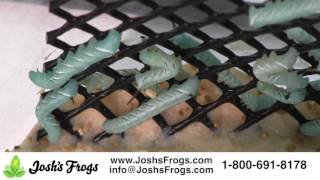
When you set up a friendly environment, it’s like opening a buffet for predators such as wasps, ladybugs, and lacewings—those tiny heroes who love to munch on hornworms. Honestly, who wouldn’t want to invite nature’s pest control into their garden? Let’s dig deeper and explore how to create the perfect habitat that will not only help these predators flourish but also contribute to a healthier garden ecosystem.
Understanding Hornworms and Their Predators
You might be wondering: what exactly are hornworms, and why should we care about their predators? Hornworms are the larvae of certain moth species, particularly the tobacco hawk moth. These little guys can quickly become a gardener’s nightmare, munching through tomato and pepper plants with impressive speed. But thankfully, nature has equipped us with some powerful allies.
Predators like parasitic wasps, who lay their eggs inside hornworms, can help keep their populations in check. Other helpful insects include ladybugs and lacewing larvae, both known for their voracious appetites for garden pests. By creating a welcoming habitat for these predators, you’re not only controlling hornworm populations but also promoting a balanced garden ecosystem.
Choosing the Right Location
Location, location, location! Just like when you’re setting up a new café, the spot you choose matters. For a hornworm-friendly habitat, look for areas in your garden that have some shelter from the wind but still receive plenty of sunlight. Think about spots near flowering plants or herbs—they attract those helpful predators we mentioned.
You might also want to consider the proximity to places where hornworms like to hang out. Vegetables such as tomatoes, peppers, and eggplants are often their favorites. A habitat close to these plants means your predators will be ready and waiting to take on the hornworm army.
Planting Predator-Friendly Flora
If you want to attract predators, you need to stock up on their favorite foods. Consider planting a mix of nectar-rich flowers and host plants for beneficial insects. Some great options include:
- Marigolds: Known for attracting ladybugs and lacewings.
- Milkweed: A favorite host for monarch butterflies, which also brings in other insects.
- Dill and fennel: Great for attracting parasitic wasps.
These plants serve as not just food sources but also offer shelter for the predators. It’s like providing a buffet and a cozy room where they can relax after feasting on hornworms.
Creating Shelter and Habitat Complexity
A diverse habitat means more than just plants. Think of it like building a multifaceted home for your tiny guests. Introduce elements like rocks, logs, and even small piles of leaves or straw to provide shelter. These nooks and crannies give beneficial insects places to hide from predators and lay eggs.
You might also want to add some taller plants to create vertical diversity. This layer helps maintain a cooler environment for beneficial insects during hot days while also providing more space for various predators to roam.
Water Sources and Maintenance
Even tiny predators need to hydrate! Ensure your habitat has a small, shallow water source. A birdbath or a small dish filled with pebbles and water can work wonders. Just make sure it’s shallow enough so that insects can land without drowning.
Routine maintenance is key as well. Regularly check your plants for pests and remove any that might overwhelm your delicate ecosystem. If hornworms appear, don’t panic. Let nature take its course; your predators might just be waiting for the feast.
Monitoring and Adjusting the Habitat
Creating a hornworm-friendly habitat isn’t a one-time job. You’ll want to monitor the interactions between your plants, the hornworms, and their predators. Keep an eye out for signs of balance—are the predators thriving? Are the hornworms under control?
If you notice that the hornworm population is still high, consider adding more predator-friendly plants or removing any excessive weeds that might be providing shelter for the pests. Be patient; ecosystems take time to stabilize, but with a little effort, you’ll see the fruits of your labor.
Final Thoughts on Your Ecosystem Effort
By creating a hornworm-friendly habitat for predators, you’re not just managing pests; you’re fostering an environment full of life and diversity. It’s like being a conductor of an orchestra, helping different elements play together seamlessly. And honestly, there’s something truly rewarding about watching nature take its course in your garden.
So grab your gardening gloves and get started! With a little planning and care, your garden can become a haven for those tiny heroes that keep hornworm populations in check. Embrace the journey, enjoy the process, and let your garden flourish.
